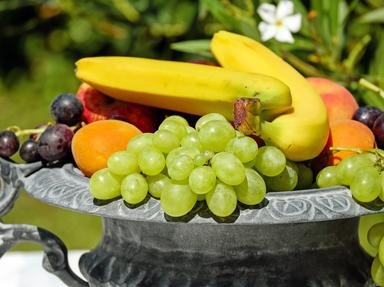Quiz Answer Key and Fun Facts
1. 'Mangifera indica' originates in India, and produces a fruit which is notoriously difficult to eat without making a mess. Featured on an episode of the television show "Seinfeld", what is this sweet fruit cultivated in many tropical and subtropical locations around the world?
2. The name of this fruit means 'dragon eye'. The shelled fruit has a black stone which can be seen through the translucent flesh, leading to the name. If you're not short on time, try to decide what its name is.
3. 'Mespilus germanica' is a native of southwest Asia which requires bletting - the fruits must go past being ripe, and actually start to decay and ferment before they can be eaten. If you're feeling like snooping around, you might find one of these in the kitchen. What fruit am I describing?
4. This fruit has a sweet rind, with a salty and sour flesh. The raw fruit may be eaten whole, although some prefer to eat only the rind. Come see what I just brought home - which of these fruits is it?
5. 'Tamar Indicus' was introduced to Europeans via India, as its name suggests, but it actually originated in Africa, where it still grows wild. What is this fruit, which is also called an 'Indian date'?
6. 'Nephelium lappaceum' produces a fruit with a distinctive 'hairy' red covering, which is the source of its name. What should I ask for if I want to sample this unusual fruit which tastes rather like a grape?
7. 'Syzygium luehmannii' is grown along the east coast of Australia as an ornamental tree and for its fruit, a berry commonly referred to as lillypilly, which is mostly used to make jam. What is its fruit's proper name?
8. The Australian native 'Santalum acuminatum' has many names in different indigenous languages, as it is widespread. What is the name for this member of the sandalwood family and its fruit, one which can come in very useful when playing Scrabble?
9. 'Monstera deliciosa' is a creeping vine native to tropical rainforests of southern Mexico and Central America which produces a fruit resembling a green ear of corn. Which of the following is NOT a common nickname for this plant?
10. Sometimes referred to in southeast Asia as 'the king of fruits', this fruit has a very strong, distinctive odour, which has led to it being banned on public transport and in some hotels in the region. What is this infamous fruit?
Source: Author
looney_tunes
This quiz was reviewed by FunTrivia editor
Bruyere before going online.
Any errors found in FunTrivia content are routinely corrected through our feedback system.

